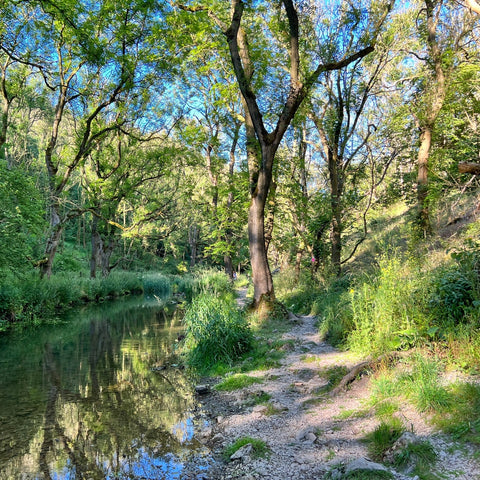Hot weather is something that we experience probably once a year in the UK, and a lot of us are not really prepared for it when the heatwave hits.
Any kind of physical exercise in the heat will increase the stresses on your body, so it's important to take care of yourself, and others, to stay safe and well.
This article covers the main risks associated with hiking or other physical exercise in hot weather, tips on how to stay cool, and how to help someone who is experiencing signs of heat exhaustion or heat stroke.

Avoid hiking very exposed routes with little or no shade on hot days.
Main risks of hiking or exercising in hot weather
- Dehydration is the first and most common risk when hiking or doing any activity in hot weather. Its easy to forget to drink enough when you’re exercising, but keeping hydrated is vital to avoid heat exhaustion or even heat stroke.
- Sunburn is another obvious risk when you spend any time outside in the summer (even the UK!).
- Heat exhaustion can easily occur when you’re doing physical exercise in hot weather, it happens when your body overheats and can't cool itself down.
- More severe than heat exhaustion is heat stroke. This occurs is the signs of heat exhaustion are missed and steps aren’t taken to cool the person down. Heat stroke is very serious and needs to be treated as an emergency.
Using a cooling towel can help regulate body temperature when hiking in hot temperatures
What is the different between heat exhaustion and heat stroke when hiking?
While heat exhaustion is not normally too serious, providing you can cool yourself down or the affected person within 30 minutes, if it is left untreated and turns into heat stroke you should call the emergency services immediately.According to the NHS, signs of heat exhaustion include:
- A headache
- Dizziness and confusion
- Loss of appetite and feeling sick
- Excessive sweating and pale, clammy skin
- Cramps in the arms, legs, and stomach
- Fast breathing or pulse
- A high temperature of 38C or above
- Being very thirsty
- The symptoms are often the same in adults and children, although children may become floppy and sleepy.
If you think you, or someone else, is showing signs of heat exhaustion you need to cool them down as quickly as possible.
If they are still feeling unwell after 30 minutes of resting in a cool place and drinking plenty of water, or didn’t recognise the signs of heat exhaustion, it could progress to heat stroke.
The signs of heat stroke include:
- Not sweating even while feeling too hot
- A high temperature of 40C or above
- Fast breathing or shortness of breath
- Feeling confused
- A fit (seizure)
- Loss of consciousness
- Not responsive

Wearing a wide-brimmed hat, sunglasses can keep the sun off your face, and reduce the risk of heat exhaustion and heat stroke.
How to help someone with heat exhaustion
If you think someone if suffering from heat exhaustion while out hiking or exercising, you need to act fast to cool them down. Follow these five steps:
- Move them to a cool place. Any shady spot will do.
- Get them to lie down and raise their feet slightly. You can use a backpack under their feet to do this.
- Get them to drink plenty of water. They may need to take regular little sips if they are feeling sick. If you have rehydration or sports drinks these will be fine, but the main thing is to get fluid inside them.
- Cool their skin. Use some water to wet their skin and fan them. If you’re near a water source or have ample drinking water between you, use this to wet a buff, towel, spare piece of clothing, and wipe/sponge this over them to help them transfer heat out of the body. Wetting their neck and armpits is helpful if you have sufficient water.
- Stay with them until they are feeling better.
They should start to cool down and feel better within 30 minutes.
If they are still not feeling better after 30 minutes, call 999 and ask for emergency assistance as it is likely to be progressing to heat stroke.

On hot days, seek out hiking routes with shaded paths, and ones with access to water sources.
How to avoid heat exhaustion and heat stroke when hiking in the UK
We get so few hot days in the UK that it’s easy to get caught out when we do. Here are some tips to help you stay safe when hiking in the heat in the UK.
- Plan your route according to the weather. Shorten your planned distance if you can, and seek out paths with potential shade (look for wooded areas on a map).
- Avoid walking when it hottest - which is generally 2-4pm - not necessarily midday! Try leaving early morning when it's cooler, or setting off late afternoon when the heat starts to reduce.
- Plan additional places to rest in the shade. Even if you normally don’t stop often on a hike, it’s important to let your body rest and cool down so you don’t overheat.
- Take more water than normal, or ensure you have a filtration device with you and known water sources on your route so you can fill up during the day.
- Sip water regularly. Consider setting a timer on your phone or GPS devise to remind you if you don’t generally drink that much.
- Wear a hat. Wide-brimmed is best, but even a peaked-cap will help to keep the worst of the sun off your head.
- Wear a high factor sun cream on exposed skin and re-apply it regularly. This will reduce the risk of getting burned which can lead to heat exhaustion.
- Wear loose, lightweight clothing. Covering up arms and legs may seem counterintuitive, but it can help reduce the risk of sunburn and heat exhaustion. Consider wearing lighter boots or shoes if your route allows it. Non-waterproof trail shoes can be much cooler and more comfortable than leather boots in hot weather.
- Use a cooling towel to help maintain a normal body temperature. Wet it when you set off and regularly re-wet it throughout the day. A river, cattle trough, or puddle will do! Wear it around your neck, or over your head (acts as shade to the side of your face too), or over your shoulders under your backpack. The material will wick away some of the heat and help you regulate your temperature.
- Recognise when its time to stop or ask for help. Fellow hikers are usually more than willing to support a hiker in need. If you’re going somewhere remote ensure your phone has sufficient battery, or carry an emergency locator beacon.
- If you or someone you’re with is experiencing signs of heat exhaustion, try to cool them down as soon as possible.
- If you think it’s heat stroke, call 999 and ask for urgent help.


